Aston Martin DB11 2016
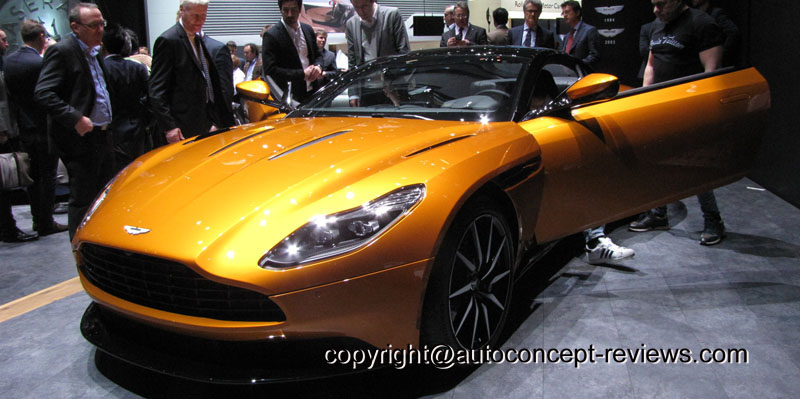
Quick Overview
1 March 2016, Geneva: A new chapter in Aston Martin’s history began at the 86th International Geneva Motor Show with the unveiling of the DB11. The first product launched under the company’s ‘Second Century’ plan, DB11 is the bold new figurehead of the illustrious ‘DB’ bloodline and an authentic, dynamic sporting GT in the finest Aston Martin tradition.
The DB11 showcases a fresh and distinctive design language, pioneering aerodynamics and is powered by a potent new in-house designed 5.2-litre twin-turbocharged V12 engine. Built upon a new lighter, stronger, and more space efficient bonded aluminium structure, DB11 is the most powerful, most efficient and most dynamically gifted DB model in Aston Martin’s history. As such, it is the most significant new Aston Martin since the introduction of the DB9 in 2003.
Aston Martin Chief Executive Officer, Dr Andy Palmer said: “We aspire to make the most beautiful cars in the world. DB11 is the absolute embodiment of what an Aston Martin should be and we have worked tirelessly to ensure that DB11 combines both exceptional design with the latest technology throughout. A brand new bonded aluminium platform, clever aerodynamics, a new characterful twin-turbo V12 and class-leading infotainment systems are just a few aspects which make this the sports car that will proudly spearhead Aston Martin’s second century plan.”
Heralding a new design era for Aston Martin, DB11 is the latest landmark in a remarkable aesthetic journey; one that gave us icons such as the DB2/4, DB5 and, most recently, the DB10 developed specifically for James Bond. DB11 re-imagines the relationship between form and function with a series of fresh design signatures. Foremost amongst these are the front-hinging clamshell bonnet, distinctive LED headlights and accentuated lines of the iconic Aston Martin grille. The profile is equally dramatic, thanks to the roof strakes that flow uninterrupted from A-pillar to C-pillar. The clean lines continue at the rear, with a sloping decklid that smoothly blends into boldly sculpted tail-lights to create a new and unmistakable graphic.
Innovative aerodynamics play their part in this aesthetic revolution with clever management of airflow both over and through the bodywork aiding stability while preserving the DB11’s uncluttered surfaces. Front-end lift is reduced by the gill-like Curlicue which releases high-pressure air from inside the wheel arch via a concealed vent within the redesigned side-strake. Meanwhile, rear-end lift is reduced by the Aston Martin AeroBladeTM; a virtual spoiler fed by discreet air intakes located at the base of each C-pillar. Air is ducted through the bodywork, before venting as a jet of air from the aperture in the rear decklid.
Like every Aston Martin, the heart of the DB11 is found beneath the bonnet, though unlike any Aston Martin before it, the DB11’s heart is a 5.2-litre twin-turbocharged V12. Designed in-house this new engine develops 608PS1 (600BHP1) and 700Nm1 of torque, making DB11 the most powerful production DB model ever. Naturally, it’s the most dynamic and most accelerative too, with a top speed of 200mph1 and a 0-62mph time of just 3.9sec1. Thanks to intelligent bank activation and stop-start technology that potency is matched by greatly improved efficiency.
To exploit the advantages of its new body structure and harness the immense performance of the new twin-turbo V12 engine, the DB11’s chassis, suspension, steering and electronics have been re-imagined and key new technologies embraced. Multiple driver-selectable dynamic modes - GT, Sport and Sport Plus - progressively intensify the response of the engine, 8-speed automatic ZF transmission together with the new electric power steering and Torque Vectoring by braking while increasing the firmness of the adaptive damping for a greater sense of agility. The result is a driving experience that combines exemplary ride comfort and true sports car agility, for an extraordinary breadth of dynamic capability.
As a true 21st century Aston Martin the DB11 combines the very latest technology developed in conjunction with technical partner, Daimler AG, with the finest quality and hand craftsmanship. Using a full-colour 12” TFT LCD display, the all-new instrument cluster presents primary vehicle information with absolute clarity, while a second, centrally-mounted 8” TFT screen is dedicated to infotainment. Controlled via an intuitive rotary control, with an optional touchpad offering character recognition, multi-touch and gesture support, the new satellite navigation and audio system have never been more effective, sounded better or been easier to operate. A newly implemented auto-park assist feature and 360-degree birds-eye view camera helps provide safe maneuvering at slow speeds and is also operated via the car’s infotainment system.
With wider door apertures, significantly increased occupant space - especially head and legroom in the rear - fully integrated rear ISOFIX mounting points for a pair of child seats plus a luggage compartment large enough to accommodate two large holdalls plus carry-on baggage, the DB11 is a genuine Grand Tourer. Thanks to an inspiring palette of colours and a vast array of detailing
options, its interior can be perfectly in-tune with your unique personal style. From calming, carefully co-ordinated tones to sharp contrasts in hue and texture, your choices are virtually limitless. Nexus quilting and Celestial perforation add layers of beautiful complexity and intrigue, while ornate leatherwork, such as intricate brogue detailing, creates areas of visual and tactile delight.
Dr Andy Palmer said: ““This is not only the most important car that Aston Martin has launched in recent history, but also in its 103-year existence. The DB11 rightfully places Aston Martin once again as a leading brand in the luxury automotive market”.
Recommended Retail Price from £154,900 in the UK2, €204,900 in Germany2 and $211,995 in USA3, first deliveries of the DB11 car are scheduled to begin during the fourth quarter of 2016.
Aston Martin DB11 : In details
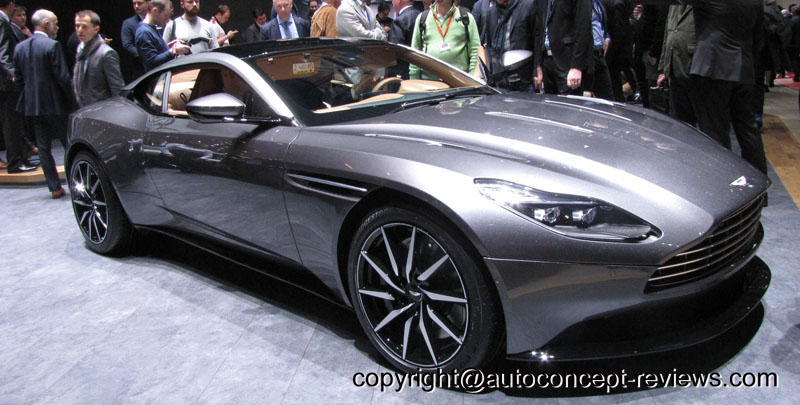
Aston Martin DB11: Design
Design Highlights:
• All-new design language for the first ‘Second Century’ series production ‘DB’ model
• One-piece forward-hinging clamshell bonnet and more prominent grille
• Full LED headlamps incorporate daytime running lights and low speed cornering lights
• Pioneering aerodynamics: side strakes now functional elements of cooling and lift reduction; new Aston Martin AeroBladeTM acts as a virtual spoiler to preserve design purity
• Roof strakes create a bold new design signature
• Dramatic new LED taillights create an unmistakable graphic
• All-new dual TFT displays: 12” primary screen for instruments, 8” secondary screen for infotainment system
• Wide choice of colour and trim as standard. Almost limitless scope for personalisation
• Intricate brogue leather detailing offered for the first time by Aston Martin
The work of Aston Martin’s award-winning in-house design team - led by Chief Creative Officer Marek Reichman - DB11 pioneers a bold new design language. One that’s unmistakably Aston Martin, yet fresh from nose to tail. Respectful of the DB line’s immaculate design legacy, but energised by the challenge of creating a successor to spearhead Aston Martin’s ‘Second Century’ plan, Reichman and his team have produced an exceptional and exciting shape that incorporates countless new details and truly ground breaking aerodynamics.
Two of the most distinctive areas of the DB11’s design are its striking new grille and clamshell bonnet. Combining familiar features with radical new ideas it gives DB11 a fresh yet unmistakable identity. In terms of Aston Martin design the front grille is a timeless and truly iconic signature. For DB11 it has been developed; amplified into a stronger and more significant feature. Exerting greater influence on the overall design, it is the source from which all the body’s form and surface lines emanate. As such, it presents a powerful symbol of DB11’s confidence and capabilities.
The clamshell bonnet is a lesson in how complete co-operation between design and engineering teams creates smart solutions to major challenges. From an aesthetic point of view the pressed aluminium bonnet satisfied the design team’s desire for a sculptural form with a minimum of shut lines interrupting the surfaces. From an engineering perspective, the clamshell also provides a smart solution to stringent pedestrian safety regulations, thanks to the large one-piece panel’s
ability to absorb and dissipate energy so effectively it avoids the need for heavy, complex active pyrotechnic safety systems. This in turn allows the bonnet line to remain as tight to the underlying hard points as possible, thereby preserving the taut lines the design team strive to achieve.
The headlights are another defining element of the DB11’s design. All-LED, they incorporate daytime running lights and low-speed cornering lights for the first time on an Aston Martin. This new technology is reflected in a much more technical look to the light units themselves, though the design team worked hard to ensure the lights retained an expressive quality to add distinction to the DB11’s ‘face’.
Flowing in an unbroken arc from A-pillar to C-pillar, the dramatic new roof strake is another bold and unmistakable DB11 design signature and a perfect example of the extraordinary lengths to which the design team will go to achieve perfection. This incredibly labour-intensive component, which is first extruded, then stretch bent, then pressed, then laser cut, then polished and finally, anodised to achieve the complex shape and flawless finish its design demands. When used in polished form the roof arc highlights the cabin with a bright ‘tick graphic’, while black finish creates a canopy effect to separate upper and lower body sections for a different, but equally dramatic effect.
Aerodynamics are a key ingredient of DB11’s design. Careful concealment and seamless integration have preserved the clean surfaces and uninterrupted flow of lines from nose to tail, while at the same time creating areas of surprise and intrigue. This integration of innovative aerodynamic solutions perhaps best expresses Aston Martin’s design philosophy of form and function working in harmony, rather than one assuming the dominant role.
Best examples of this are the re-imagined side strake - a time-honoured Aston Martin design element - which now forms part of the ‘Curlicue‘ vent that extracts high-pressure air from the front wheel arch to reduce lift. Likewise, the Aston Martin AeroBladeTM is a truly innovative ‘virtual spoiler’. Fed via discreet intakes located at the base of the c-pillars air is channelled through ducts that pass within the body, before exiting via slots in the rear deck lid to create a jet of disrupted air that reduces rear lift. Freed from the need to incorporate a ‘flip‘ profile to spoil the airflow, the design team could give the DB11 its distinctive sloping tail without any compromise in stability.
Like the frontal treatment, the tail is a powerful element of the overall DB11 design, the most striking element being the LED taillights. Retaining the boomerang graphic by which all modern Aston Martins can be recognised, DB11’s lights are a far more three-dimensional component thanks to what our designers refer to as the ‘discus section‘ that at once integrates the lights into
the overall rear-end treatment, but also serve to separate the upper and lower sections of the tail. Like the rest of the design it’s a super-modern feature, yet very definitely an Aston Martin.
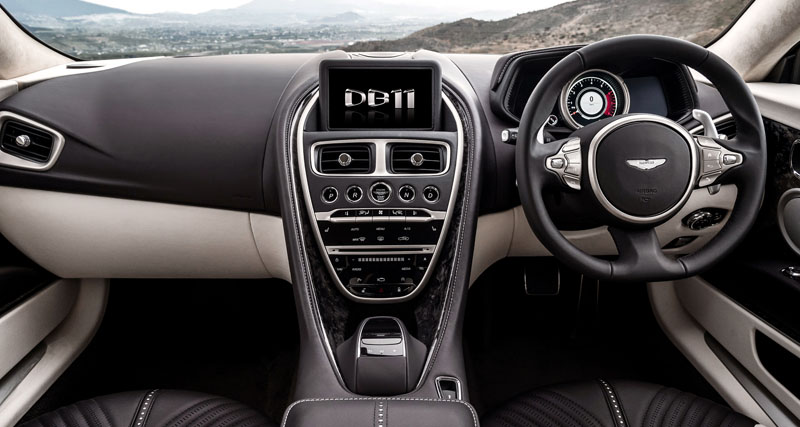
DB11’s progressive, contemporary exterior design is mirrored in the interior. Key Aston Martin design elements remain, but in re-imagined form. The main TFT instrument display has a technical look, while the centre console remains a smooth cascade that flows from the dashboard down to the transmission tunnel. Gentle lines flowing fore to aft through the cabin create an unhurried elegance that’s both spacious and intimate, cosseting, but not cramped. Stylish, looping lines that come back on themselves to picture frame details within the door panels add interest and visual stimulation. No question, DB11 provides a magnificent environment for driver and passengers alike.
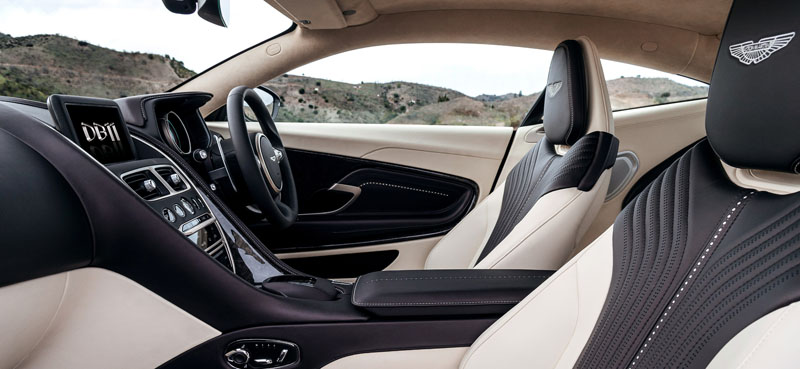
Fine materials and highly skilled hand-craftsmanship are the DB11 interior’s crowning glory. Continuing the tradition established by DB9, DB11 presents traditional materials and techniques in modern, dynamic ways that suits the car’s sporting character. Trim inlays have been brought up to date, with some woods shunning high-gloss finish for open grains in which you can see and feel the texture. It looks more natural and authentic.
Likewise, DB11 is a showcase for some of the most imaginative use of leather you’ll find in any car at any price. Quilting. Perforation. Brogueing. Each technique adds a different layer of intricacy, detail and delight to the interior. Made, rather than manufactured, it’s what gives DB11 its warmth of character and why the Aston Martins of today and tomorrow will always be a true expression of craftsmanship.
Chief Creative Officer, Marek Reichman said: “Every millimetre of DB11 has been re-imagined from the ground up. The DB11’s proportions have been thoroughly scrutinised, and intuitively measured, to ensure its beauty and elegance, while ground-breaking aerodynamics have been integrated to further enhance the car’s design language. Even down to the hidden detailing, every part of DB11 is designed to create the world’s most alluring DB to date”.
Innovative aerodynamics play their part in this aesthetic revolution with clever management of airflow both over and through the bodywork aiding stability while preserving the DB11’s uncluttered surfaces. Front-end lift is reduced by the gill-like Curlicue which releases high-pressure air from inside the wheel arch via a concealed vent within the redesigned side-strake. Meanwhile, rear-end lift is reduced by the Aston Martin AeroBladeTM; a virtual spoiler fed by discreet air intakes located at the base of each C-pillar. Air is ducted through the bodywork, before venting as a jet of air from the aperture in the rear decklid.
Like every Aston Martin, the heart of the DB11 is found beneath the bonnet, though unlike any Aston Martin before it, the DB11’s heart is a 5.2-litre twin-turbocharged V12. Designed in-house this new engine develops 608PS1 (600BHP1) and 700Nm1 of torque, making DB11 the most powerful production DB model ever. Naturally, it’s the most dynamic and most accelerative too, with a top speed of 200mph1 and a 0-62mph time of just 3.9sec1. Thanks to intelligent bank activation and stop-start technology that potency is matched by greatly improved efficiency.
To exploit the advantages of its new body structure and harness the immense performance of the new twin-turbo V12 engine, the DB11’s chassis, suspension, steering and electronics have been re-imagined and key new technologies embraced. Multiple driver-selectable dynamic modes - GT, Sport and Sport Plus - progressively intensify the response of the engine, 8-speed automatic ZF transmission together with the new electric power steering and Torque Vectoring by braking while increasing the firmness of the adaptive damping for a greater sense of agility. The result is a driving experience that combines exemplary ride comfort and true sports car agility, for an extraordinary breadth of dynamic capability.
As a true 21st century Aston Martin the DB11 combines the very latest technology developed in conjunction with technical partner, Daimler AG, with the finest quality and hand craftsmanship. Using a full-colour 12” TFT LCD display, the all-new instrument cluster presents primary vehicle information with absolute clarity, while a second, centrally-mounted 8” TFT screen is dedicated to infotainment. Controlled via an intuitive rotary control, with an optional touchpad offering character recognition, multi-touch and gesture support, the new satellite navigation and audio system have never been more effective, sounded better or been easier to operate. A newly implemented auto-park assist feature and 360-degree birds-eye view camera helps provide safe maneuvering at slow speeds and is also operated via the car’s infotainment system.
With wider door apertures, significantly increased occupant space - especially head and legroom in the rear - fully integrated rear ISOFIX mounting points for a pair of child seats plus a luggage compartment large enough to accommodate two large holdalls plus carry-on baggage, the DB11 is a genuine Grand Tourer. Thanks to an inspiring palette of colours and a vast array of detailing, every part of DB11 is designed to create the world’s most alluring DB to date”.
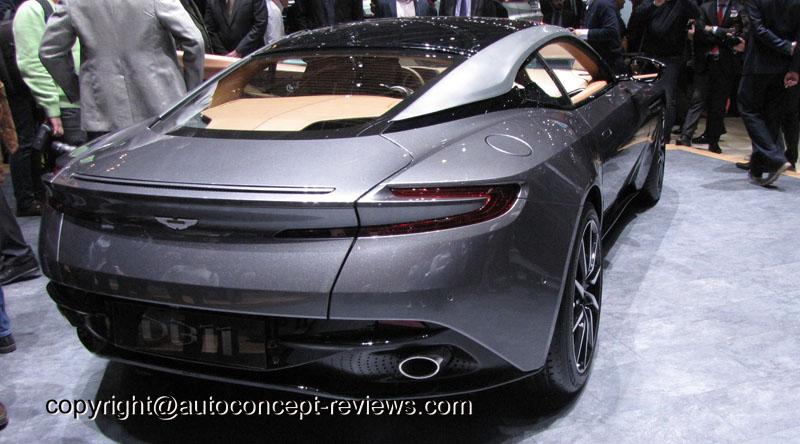
Aston Martin DB11: Engineering
Engineering Highlights:
• Lightest, stiffest and most space-efficient Aston Martin bonded-aluminium body structure
• Body structure optimised mix of bonded aluminium pressings, extrusions and castings
• Body structure achieves class-leading mass vs stiffness
• Height and width of sill sections reduced to increase apertures, aiding ingress and egress
• New front seat mounting points to accommodate wider range of occupants
• Significantly increased headroom and legroom in rear passenger compartment
• Integrated ISOFIX mounting points in the rear to enable fitment of child seats
• Larger luggage compartment accommodates a full set of luggage
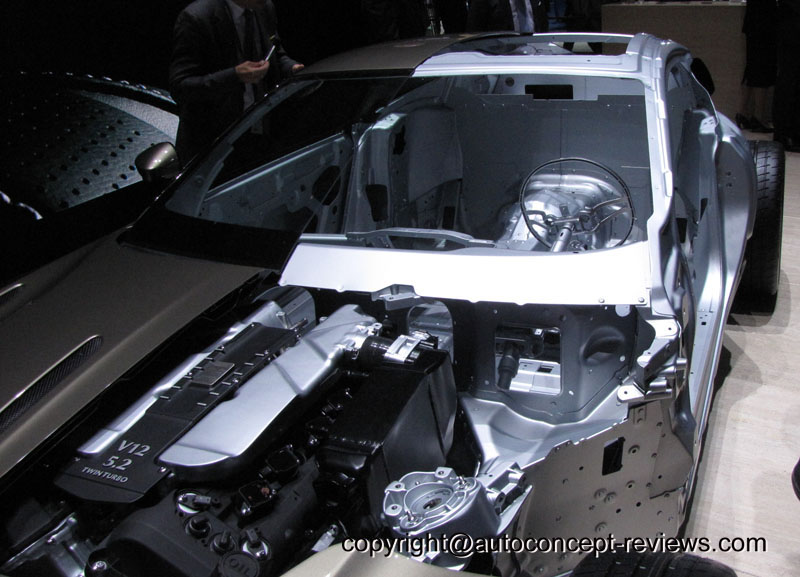
Lighter, stronger, more dynamic and space-efficient. These are the ambitious targets that were set when creating DB11. As leaders in bonded aluminium construction we achieved every single one. With its aluminium structure, front-mounted V12 engine and rear-wheel drive, DB11 takes the established Aston Martin blueprint and evolves it into the ultimate modern sporting Grand Tourer. Though many of these improvements and innovations are hidden from view, you can feel them at work in every facet of the car.
Utilising a mix of new bonded aluminium pressings, extrusions and castings, DB11’s body structure sets new standards for mass vs stiffness. The body panels are made from a mix of pressed aluminium for the clamshell bonnet, roof and doors, composite material for the rear haunches, front wings and rear decklid assembly and injection moulded plastic for the front and rear bumpers, sills, front splitter and rear diffuser. The roof strakes are formed from extruded and pressed aluminium.
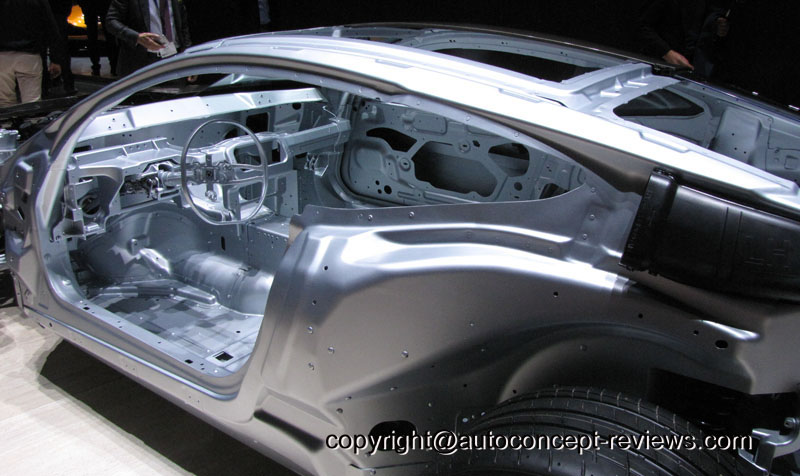
Increasing the wheelbase by 65mm has enabled us to mount the V12 engine further back in the chassis to achieve near-perfect weight distribution and agile handling. Compared with DB9, front and rear track widths have increased by 75mm and 43mm respectively, while the overall width has increased by just 28mm. The front overhang has been reduced by 16mm and the rear overhang increased by 11mm, with an overall gain in length of 50mm.
A new, more efficiently packaged fuel tank enables the luggage compartment to accommodate a full luggage set. Redesigned A-pillar structures and a reduction in the height and width of the sill sections increases the size of the door apertures to ease ingress and egress. Front seat occupants benefit from a useful 10mm increase in headroom and a greater range of seat movement, while in the rear a 54mm increase headroom, 87mm gain in legroom ensure DB11 is a true 2+2. And, for the first time in an Aston Martin, rear ISOFIX points allow for the fitment of two child seats in the rear, further expanding DB11’s practicality.
Director of Product Development, Ian Minards said: “We have taken everything that we have learned over a decade of utilising bonded aluminium and created a significantly improved body structure as a result. It was absolutely vital that the new bodyshell provided DB11 with additional stiffness, but with reduced mass and hence the opportunity for optimised dynamic performance. This has helped to ensure that this is the best GT sports car that Aston Martin has ever produced. I am confident that our engineering team at Gaydon has not disappointed."
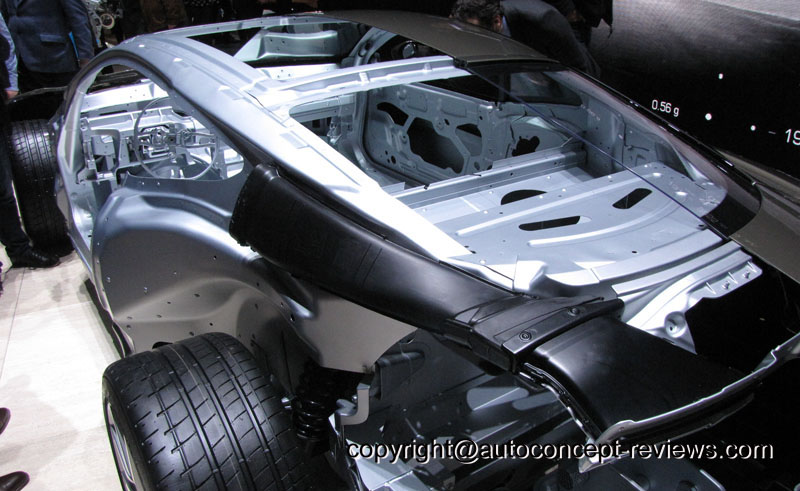
Aston Martin DB11: Powertrain
Powertrain Highlights:
• New 5.2-litre twin-turbocharged V12 engine designed by Aston Martin’s in-house powertrain team and manufactured at Aston Martin’s engine facility
• Outputs of 608PS and 700Nm make it the most powerful ‘DB’ model ever1
• Fastest and most accelerative ‘DB’ model in history: Top speed 200mph1; 0-62mph time of just 3.9sec1
• Intelligent bank activation and stop-start also make it the most efficient
• 8-speed transaxle with repositioned differential for improved packaging and interior space
Designed in-house by Aston Martin’s powertrain team - headed by Chief Powertrain Engineer Brian Fitzsimons - this new 5.2-litre twin-turbo V12 is the DB11‘s beating heart. Developing 608PS1 and 700NM1 of torque, the twin-turbocharged engine - a first for a series production Aston Martin - is the most powerful ever fitted to a ‘DB’ road car. A top speed of 200mph1 and the capability to accelerate from 0-62mph in 3.9sec1 confirm its performance credentials.
Thanks to state-of-the-art variable valve timing, intelligent bank activation and stop-start technology it is also the most fuel efficient. By imperceptibly shutting down one bank of cylinders during periods of low demand - such as when cruising, lift-off or under light acceleration - significantly less fuel is consumed. To ensure catalyst temperatures remain within their operating range during periods of deactivation, when the dormant catalyst reaches its minimum temperature threshold the management system switches activation to that cylinder bank. This smart and seamless solution delivers much improved efficiency and lower emissions without compromising performance or driving enjoyment when the full power and torque of this exceptional engine can be utilised.
Crucially this new engine is not just a collection of impressive numbers. It also has abundant character, thanks to its tremendous breadth of performance, exceptional response and authentic V12 soundtrack. We were adamant DB11 should have an honest, genuine engine note, so what you hear comes purely from the intake and exhaust, not from speakers pumping sythesised sound into the cockpit. This sound quality plays an important part in the overall driving experience. Each dynamic driving mode turns the level of noise up or down, and with it the level of emotional character and connection. GT mode keeps the noise levels at a satisfying simmer, but select Sport
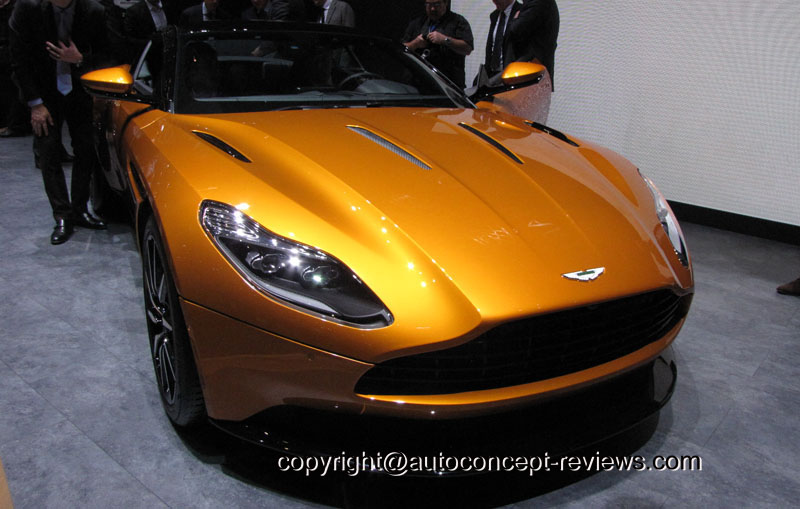
Aston Martin DB11: Driving Dynamics
Driving Dynamics Highlights:
• Sets new standards for ride comfort and sporting handling, as befits the world’s finest GT
• Driver selectable GT, Sport and Sport Plus modes offer an unrivalled breath of character and capability
• Improved response and isolation from road imperfections
• Latest generation adaptive damping system for ultimate wheel and body control
• Electric Power Assisted Steering offers greater scope for tuning and improves fuel efficiency
• Active Torque Vectoring improves turn-in response and handling agility
• Bridgestone S007 tyres with unique construction for DB11
To exploit the advantages of its new body structure and harness the immense performance of the new twin-turbocharged V12 engine, DB11’s chassis, suspension, steering and electronics have been completely re-worked and new technologies embraced. The result is a driving experience of extraordinary breadth and capability.
The most potent DB ever demands the most sophisticated and capable chassis. To this end the DB11 suspension system combines with the latest generation Bilstein adaptive damping, Active Torque Vectoring via brakes and multiple driver-selectable dynamic modes giving DB11 chameleon-like adaptability to the road and the ability to ramp-up its responsiveness and sporting characteristics on-demand.
The key to this breadth of character are the three dynamic driving modes and the interaction between those areas of the chassis that contribute to class-leading steering, ride, and handling. To achieve this, the chassis takes information from multiple sources to build a three-dimensional picture of the forces acting upon it. These sources include sensors monitoring vehicle speed, steering angle and steering rate, lateral and longitudinal acceleration and vertical movement. Painstaking tuning and calibration of the latest generation Bilstein adaptive damping, electric power steering and Active Torque Vectoring via brakes ensure DB11 delivers the appropriate feel and response for any given situation or style of driving.
Each of the dynamic driving modes has its own distinct character, but nothing is contrived. Rather each offers a carefully honed progression from one to the next for a natural, intuitive consistency of feel. Select GT mode and you’ll marvel at the exemplary ride quality and maturity of character. Switching to Sport adds a touch more firmness, control and response to the damping, while the new electric power steering and Active Torque Vectoring via brakes adjust to quicken the rate of response for a greater sense of agility. Selecting Sport Plus mode turns-up the intensity; suspension, steering, engine, transmission and Active Torque Vectoring system working in unison to truly awaken the sports car within and connect the driver more directly to the action.
Aston Martin’s dynamics team has worked closely with Bridgestone; the official technical partner for tyre development on DB11. The resulting bespoke Bridgestone S007 tyre has a unique tread pattern, construction and compound for the DB11 for improved wet weather performance, more progressive on-limit behaviour and consistent handling in wet and dry conditions. Tyre sizes are 255/45 front and 295/35 rear and fitted to 9Jx20in (front) and 11Jx20in (rear) cast flow formed alloy wheels. The front brakes are 400mm cast iron discs ‘floating’ on an aluminium bell, with 6-piston monobloc calipers. Rear discs are 360mm cast iron discs with an integrated cast aluminium bell and 4-piston monobloc calipers.
Chief of Vehicle Attribute Engineering, Matt Becker said: “We have assessed and developed every aspect of DB11 to ensure its dynamic ability met and exceeded all of the targets that we set out at the beginning of this project. Through utilising the settings of GT, Sport and Sport Plus, we have been able to give DB11 three thoroughly distinctive characters, ensuring customers are equipped with a very capable car for different road conditions and driver requirements”
Aston Martin DB11: Aerodynamics
Aerodynamics Highlights:
• Pioneering new airflow concept is the subject of a patent application
• New Curlicue apertures extract high-pressure air from front wheel arches through reimagined side strake vents to reduce frontal lift
• Additional high-pressure air escapes though ‘stirrup vents‘ in the sills
• Innovative Aston Martin AeroBladeTM uses ducted high-speed airflow to act as a virtual spoiler
• Small active spoiler deploys from decklid to further reduce lift at the rear
In the quest for increased performance and efficiency our aerodynamics team embarked on an extraordinary journey.
Led by Darren Coe, Aston Martin’s Aerodynamics Manager, the team explored ideas that not only mastered the airflow over and around its bodywork, but pioneered innovative ways of flowing air through its bodywork. The inspired results are two powerful, yet beautifully simple solutions to the perennial problem of reducing lift, increasing stability and minimising drag. We call them Curlicue and the Aston Martin AeroBladeTM.
Derived directly from our race cars and recently integrated into the Aston Martin Vulcan track-only supercar, Curlicue is a gill-like vent incorporated into each front wheel arch lining to reduce unwanted front-end aerodynamic lift. Neatly concealed beneath the clamshell bonnet, the Curlicue works by venting high-pressure air from the top of each front wheel arches though recessed apertures behind the iconic Aston Martin side strakes. Further high pressure air is extracted from the back of each wheel arch through discreet stirrup vents positioned aft of the front wheels.
The Aston Martin AeroBladeTM harnesses airflow that has been carefully and precisely directed along the DB11’s flanks to enhance stability at the rear. Intake slots incorporated in the base of the c-pillars are fed with high-speed airflow, which then passes within the bodywork through specially contoured ducting before venting via discreet slots in the rear decklid. Acting like a virtual spoiler, this jet of disrupted air reduces aerodynamic lift, cleverly obviating the need for an upswept ‘flip’ in the tail. This in turn provided our design team with the freedom to create DB11’s distinctive sloping tail, once again illustrating how Aston Martin’s philosophy of close collaboration between design and engineering teams creates a product where form and function have parity.
When maximum stability is needed a small active spoiler automatically deploys from the decklid. Acting like a ‘Gurney’ flap commonly seen on race cars, this discreet active spoiler increases the effectiveness of the Aston Martin AeroBladeTM with negligible increase in drag. At lower speeds when no longer required, it retracts back into the decklid to preserve the DB11’s uncluttered lines.
In addition to harnessing the power of the air flowing over and through the body, careful attention has also been paid to DB11’s underfloor aerodynamics. Again using knowledge gained from Aston Martin’s motorsport programmes, the front splitter is fully functional, its size and shape precisely tuned to manage the amount of air that flows through the grille into the radiator for cooling, and how much is directed beneath the car to feed the rear diffuser.
Aerodynamics Manager, Darren Coe said: “We’ve really pushed the boundaries with DB11, particularly with the latest Aston Martin AeroBladeTM system. Working alongside Design, we’ve created not only a cleaner and more beautiful shape but also an incredibly effective and efficient aerodynamic instrument. Combining this with the other areas of development such as the Curlicue and underfloor, the DB11 remains the most stable and capable GT car at high speed than any other Aston Martin”.
or Sport Plus and the engine noise becomes progressively more intense. Conversely when you wish to be as discreet as possible a new ‘quiet start‘ offers a low-key alternative to DB11’s otherwise rousing flare of revs on start-up.
Thermal management of the engine is handled by a pair of water charge air coolers (WACACs) mounted on either side of the engine. The water-air system was chosen over an air-to-air system as it offers the shortest charge air path to help minimise charge inertia and improve throttle response.
DB11’s transmission is an 8-speed paddle-shift torque converter automatic gearbox. A development of that found in the Vanquish and Rapide S, DB11’s transaxle features a mechanical limited-slip differential with Active Torque Vectoring - a first for Aston Martin. Redesigned to improve packaging, the differential uses a pair of rear-mounted transfer gears to enable the location of the crown wheel alongside the transmission. This shortens the transaxle assembly by 60mm, allowing the transmission to be mounted further rearwards to facilitate gains in the range of front seat adjustment.
Chief Powertrain Engineer, Brian Fitzsimons said of the new 5.2-litre V12: “It was of paramount importance to ensure that we pushed the boundaries on both performance and efficiency whilst retaining characteristic class leading V12 sound quality. Creating our twin-turbocharged powertrain has been a significant but fantastic challenge and we’re very proud to have engineered a great new British V12 engine to enable DB11 to be the most characterful and capable all round GT car that this brand has produced”
Aston Martin DB11 Specification
Body |
- Two-door body style 2+2 seating
- Extruded bonded aluminium body structure including Hot Form Quenched (HFQ) aluminium
- Cast-magnesium door structures
- LED headlamps with integrated daytime running, side lights and cornering lights
- LED light blade tail-lamps
- Deployable spoiler with Aston Martin AeroBladeTM system
- One-piece clamshell with soft-close latches
- Curlicue aero feature in front wing |
Engine |
- All-alloy quad overhead cam, 48 valve, 5.2-litre twin-turbo V12
- 5204cc
- Charge Cooling
- Front mid-mounted engine, rear-wheel drive
- Fully catalysed stainless steel exhaust system with cross pipes
- Compression ratio 9.2:1
- Dual Variable Camshaft Timing
- Knock-sensing
- Fully CNC machined combustion chambers
- Electrically controlled exhaust
- Intelligent Bank Activation
- Infinitely variable electronic turbo wastegate control
- 115bhp/litre at 6500rpm
- Maximum power: 447kW (600bhp / 608PS) at 6500 rpm11
- Maximum torque: 700Nm (516 lb ft) at 1500-5000 rpm11
- Acceleration: 0-62mph (0-100 km/h) in 3.9seconds11
- Maximum Speed: 200 mph (322 km/h)11 |
Transmission |
- Rear mid-mounted ZF eight-speed automatic gearbox with electronic shift-by-wire control system
- Alloy torque tube with carbon fibre propeller shaft
- Limited-slip differential
- Final drive ratio 2.703:1 |
Steering |
- Electric power-assisted steering rack with 13:1 steering ratio
- Speed-dependent rack and pinion power-assisted steering, 2.4 turns lock-to-lock
- Electric column tilt and reach adjustment |
Suspension |
- Front: Independent double wishbone, coil springs, anti-roll bar and adaptive dampers
- Rear: Multi-link, coil springs, anti-roll bar and adaptive dampers
- Three-stage Adaptive Damping System (ADS) – GT, Sport & Sport + |
Dimensions and other specifications |
Length: 4739 mm (including number plate plinth)
Width: 1940 mm (excluding door mirrors)
2060 mm (including door mirrors)
Height: 1279 mm
Wheelbase: 2805 mm
Fuel tank capacity: 78 litres (17.2 Imp. Gal. /20.5 US Gal)
Luggage capacity: 270 litres
Weight: 1770 kg dry weight
Weight Distribution: 51%/49% (front/rear) |
Aston Martin DB11 2016 : Wallpapers
|